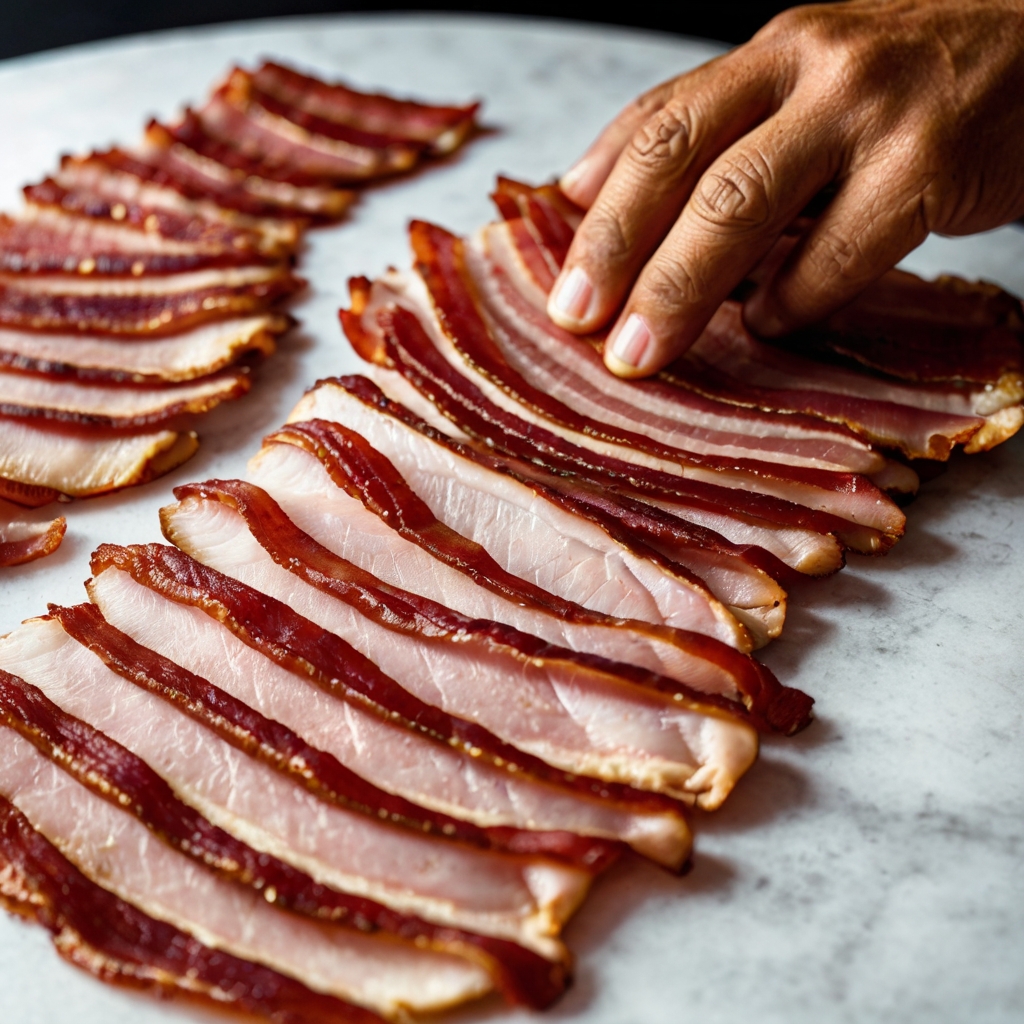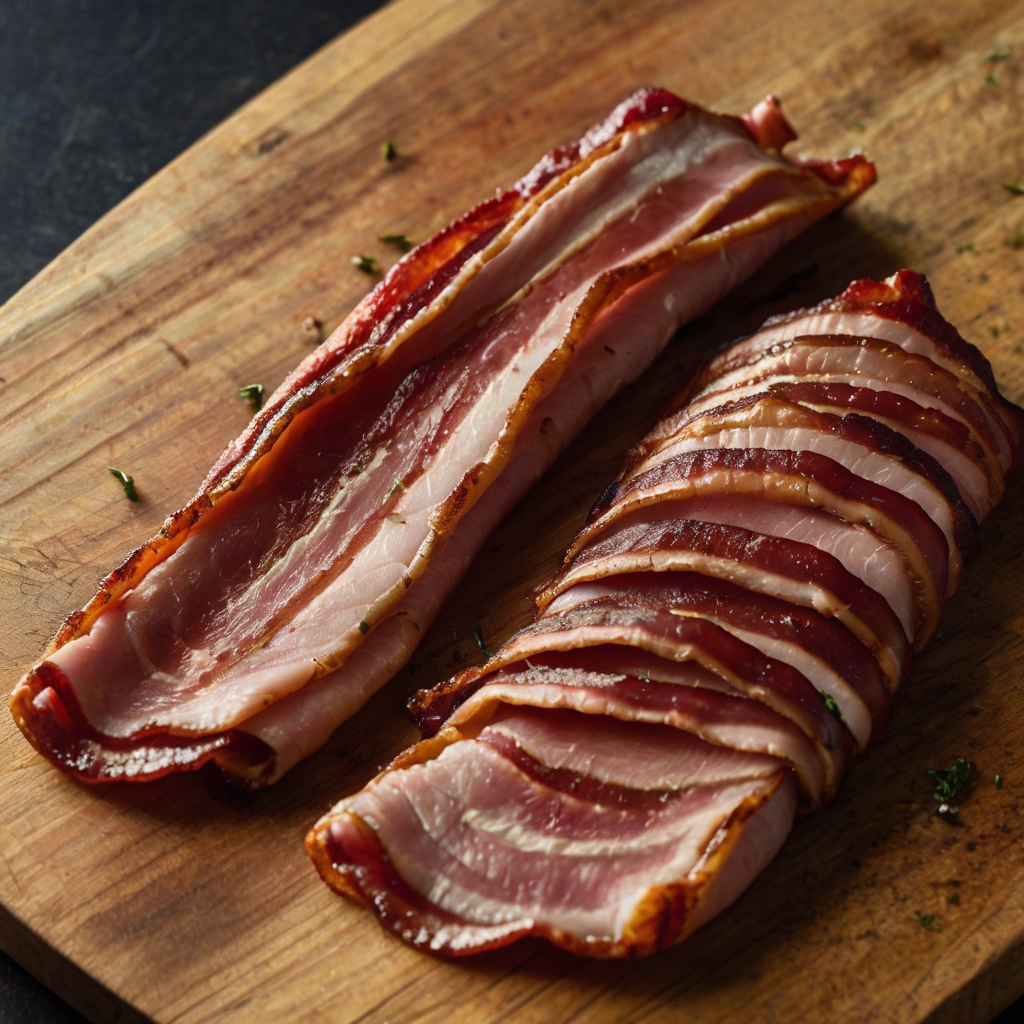How to Cook Turkey Bacon: Guide for beginners

Hi, my name is Chef Marcus. I’ve been working in kitchens for over 20 years, from bustling New York brunch spots to serene California beach cafés, and I’ve cooked bacon in every form imaginable. But turkey bacon? That’s a whole different beast. Or bird, rather. Whether you’re looking for a leaner breakfast option or just curious about the hype, I’m here to guide you through everything you need to know about cooking turkey bacon to crispy, juicy perfection.
What Is Turkey Bacon?

Turkey bacon is a popular alternative to traditional pork bacon, made by combining ground turkey with seasonings and preservatives, then shaping it into strips that resemble pork bacon. It’s leaner, lower in fat, and often marketed as a healthier choice. But don’t let the word “alternative” fool you—when cooked properly, turkey bacon can bring just as much flavor to the plate.
Turkey Bacon vs. Pork Bacon: What’s the Difference?
Flavor and Texture Comparison
Turkey bacon has a milder, slightly smoky flavor with a chewy texture that’s different from the crisp, fatty snap of pork bacon. It’s leaner, so it doesn’t render the same amount of fat when cooking—meaning you’ll need to get creative to achieve that golden-brown crunch.
| Feature | Turkey Bacon | Pork Bacon |
| Flavor | Mild, slightly smoky | Rich, salty, smoky |
| Texture | Lean, chewy, less greasy | Crisp, fatty |
| Cooking Time | Shorter | Longer due to higher fat |
| Fat Content | Lower | Higher |
| Ideal Uses | Wraps, salads, breakfasts | Classic breakfasts, burgers |
Nutrition and Calories
Turkey bacon generally contains fewer calories and fat per slice than pork bacon, but check the label—some brands add sugar or sodium to compensate for the reduced fat.
| Per 1 Slice (approx.) | Turkey Bacon | Pork Bacon |
| Calories | 35–50 | 80–100 |
| Fat (g) | 2–3 | 7–9 |
| Protein (g) | 2–4 | 5–6 |
| Sodium (mg) | 200–300 | 300–400 |
Is Turkey Bacon Healthy?
Pros and Cons
Pros:
- Lower in saturated fat
- Fewer calories per serving
- Can be a good option for low-fat diets
Cons:
- Often high in sodium
- Can include preservatives and additives
- Less satisfying if you crave the richness of pork bacon
Nitrate-Free and Uncured Options
Many brands now offer nitrate-free or uncured turkey bacon, which are great choices if you’re looking to avoid added chemicals. I recommend brands that list real spices and smoke flavoring rather than artificial ones.
Look for labels like:
- “Uncured turkey bacon”
- “No nitrates or nitrites added”
- “Minimally processed”
How to Cook Turkey Bacon
Now for the fun part. Turkey bacon isn’t as forgiving as pork bacon, so technique matters. Too hot, and it dries out. Too cool, and you’ll get rubbery strips. Here’s how I handle each method.
How to Cook Turkey Bacon on the Stove
Skillet Cooking Tips for Crispy Results
- Use a nonstick or cast-iron skillet.
- Heat on medium-low—turkey bacon burns fast.
- Lay slices flat; don’t overcrowd the pan.
- Cook 3–5 minutes per side until golden brown.
- Press with a spatula for extra crispiness.
Chef’s Tip: Add a teaspoon of olive oil for better browning and flavor.
How to Avoid Dry or Burnt Strips
Keep your eye on it—turkey bacon doesn’t give visual cues like pork bacon (no curling or sizzling fat). Flip gently and often. Lower heat if it starts to darken too quickly.
How to Cook Turkey Bacon in the Oven
Best Temperature and Timing
- Preheat oven to 400°F (200°C)
- Line a baking sheet with parchment paper
- Arrange slices without overlap
- Bake for 10–12 minutes, flip halfway
Chef’s Tip: For ultra crispiness, finish under the broiler for 1–2 minutes.
Using a Rack vs. Direct on Pan
- Rack method: Grease drips away, texture is drier and crisper.
- Pan method: Bacon cooks in its own juices—richer flavor, softer texture.
Use a rack if you’re going low-fat. Use the pan if you’re going for full taste.
How to Cook Turkey Bacon in the Microwave
Quick Method with Paper Towels
- Place 2–4 slices on a microwave-safe plate
- Cover with two layers of paper towel
- Microwave on high for 1 minute per slice
When to Use (and When Not To)
Use the microwave if you’re in a rush—it’s fast and clean. But don’t expect gourmet-level crisp. It’s chewy, and that’s okay for sandwiches or quick snacks.
How to Air Fry Turkey Bacon
Ideal Time and Temperature Settings
- Preheat air fryer to 375°F (190°C)
- Cook for 5–7 minutes, flipping halfway
How to Prevent Curling or Overcooking
- Don’t overcrowd the basket
- Weigh down slices with a rack or small tray
- Check early—the air fryer gets hot fast
Chef’s Tip: Spritz with oil for added crisp and color.
Serve Turkey Bacon
Turkey bacon isn’t just a breakfast sidekick—it’s a flexible, flavorful ingredient that works in everything from elegant brunches to quick weeknight meals. Over the years, I’ve used it in dozens of creative ways, and here are some of my personal favorites.

Breakfast Classics with a Twist
If you’re swapping pork for turkey bacon, here’s how to make sure the rest of your plate plays nice.
Turkey Bacon & Eggs Done Right
I like to pair crispy turkey bacon with soft scrambled eggs or a poached egg on whole-grain toast. Add sliced avocado or sautéed spinach for a balanced breakfast.
| Breakfast Combo | Why It Works |
| Turkey bacon + scrambled eggs | Balanced texture: crispy + fluffy |
| Poached egg + turkey bacon toast | Protein-packed and visually elegant |
| Turkey bacon + veggie omelet | Light, fresh, and packed with nutrients |
Chef’s Tip: Crumble cooked turkey bacon into your omelet or frittata for savory crunch without the grease.
Pancakes, Waffles, and Savory Syrup Pairings
Don’t skip turkey bacon when you’re craving sweet-and-savory. That salty-smoky bite cuts through syrupy sweetness like a pro.
- Serve turkey bacon alongside banana pancakes or cinnamon waffles.
- Drizzle maple syrup over the bacon itself for a flavor upgrade.
Yes, I drizzle syrup on my turkey bacon. Don’t knock it till you’ve tried it.
Sandwiches, Wraps, and Salads
Turkey bacon is sandwich gold. It’s lean, flavorful, and holds up under pressure.
BLT (The TB-LT)
Swap the pork for turkey, keep the crisp lettuce and ripe tomatoes, and add a swipe of lemon aioli or avocado spread. Toasted sourdough takes it to the next level.
Wrap It Up
Turkey bacon works beautifully in wraps—try it with grilled chicken, romaine, and Caesar dressing, or toss it in with hummus, cucumber, and red pepper for a Mediterranean spin.
Salad Upgrades
Crispy turkey bacon makes a perfect topping:
| Salad Type | Why Add Turkey Bacon |
| Cobb | Classic choice, lower fat |
| Spinach & Goat Cheese | Adds crunch and savory balance |
| Quinoa & Avocado | Complements creamy textures and grains |
Crowd-Pleasing Appetizers and Snacks
When I host events, turkey bacon is my secret weapon for lighter apps that still feel indulgent.
- Turkey Bacon-Wrapped Dates – Sweet, salty, chewy. Use toothpicks and bake until crisp.
- Mini Turkey Bacon Sliders – Add to small brioche buns with a slice of tomato and spicy mayo.
- Deviled Eggs with Bacon Crumbles – A sprinkle of crispy turkey bacon on top changes the game.
Chef’s Tip: Bake a batch of turkey bacon ahead of time and crumble it into an airtight jar. Use it like seasoning all week long.
Tips and Tricks for Perfect Turkey Bacon
Cooking turkey bacon is all about finesse—it doesn’t have the fat cushion pork bacon does, so timing, heat, and a few pro tricks make all the difference. After two decades in the kitchen, these are my go-to secrets for getting it right every single time.
How to Make It Crispy Without Overcooking
Crispy doesn’t mean dry. Here’s how I strike the balance:
- Low and slow: Medium-low heat gives the fat time to render and crisp the edges.
- Press it: Use a spatula or a small grill press to keep it flat and even on the pan.
- Flip early, flip often: Don’t walk away—turning frequently helps avoid burnt edges.
- Use a rack: In the oven, elevating bacon on a rack allows air to circulate for a crispier finish.
Chef’s Tip: If it looks done, it’s probably already overdone. Pull it off the heat just before it looks perfect.
Do You Need Oil to Cook Turkey Bacon?
Technically, no. But should you? In my book—yes, just a touch.
Because turkey bacon is lean, adding ½ to 1 teaspoon of oil (olive, avocado, or even butter) can:
- Help with even browning
- Prevent sticking
- Boost flavor
Use oil if:
- You’re using stainless steel or cast iron
- You want that crispy edge without overcooking
Skip oil if:
- You’re air frying
- You’re aiming for ultra low-fat cooking
How to Season Turkey Bacon (Optional Ideas)
Turkey bacon is usually pre-seasoned, but I like to play with flavors when the dish calls for it. Try these:
| Seasoning | When to Use It |
| Black pepper | Classic, adds heat and contrast |
| Smoked paprika | Enhances the smokiness |
| Maple glaze | Perfect for brunch or sweet-savory wraps |
| Garlic powder | Great in sandwiches or wraps |
| Chili flakes | Add a spicy twist for tacos or bowls |
Just remember: season lightly. Turkey bacon doesn’t need much to shine.
Storage and Leftover Tips
So, you’ve made a batch—and now you’ve got leftovers. Lucky you. Proper storage makes turkey bacon a meal-prep MVP.
How to Store Cooked Turkey Bacon
Refrigerator Storage Guidelines
- Let bacon cool completely before storing.
- Use an airtight container or wrap tightly in foil.
- Store in the fridge up to 4–5 days.
| Storage Step | Why It Matters |
| Cool completely | Prevents condensation = sogginess |
| Airtight wrapping | Keeps moisture and odors out |
| Date your container | Avoid mystery bacon three weeks later |
Chef’s Tip: Store with a paper towel in the container to absorb excess moisture.
Can You Freeze Cooked Turkey Bacon?
Absolutely—and I do it all the time for meal prep.
- Lay slices flat on parchment, freeze individually.
- Transfer to a freezer-safe bag or container.
- Good for up to 2 months.

To reheat: Pop frozen slices in a skillet for a couple minutes, or microwave with a paper towel.
Reheating Turkey Bacon Without Drying It Out
Dry turkey bacon is the quickest way to ruin a good breakfast. Here’s how I bring it back to life:
| Method | Instructions | Texture Result |
| Skillet | Low heat, flip frequently, 1–2 mins | Crispy and fresh |
| Oven | 350°F for 5–7 mins on parchment | Even and warm |
| Microwave | 10–15 sec per slice with paper towel | Softer, good for wraps |
Avoid reheating at high heat—turkey bacon dries out fast. Slow and steady wins.
15 FAQ About Turkey Bacon
1. Can you eat turkey bacon raw?
Most turkey bacon is pre-cooked, but I never recommend eating it cold from the package. Always heat it up—it’s safer and way tastier.
2. Why is my turkey bacon rubbery?
You likely undercooked it or used too low heat. Try medium-low heat and a bit of oil for better browning.
3. Is turkey bacon healthier than pork bacon?
It’s lower in fat and calories, yes—but often higher in sodium. So it’s a trade-off. Read your labels.
4. Can I cook turkey bacon from frozen?
Yes, but separate the slices first and cook on slightly lower heat to avoid burning the edges before the center heats through.
5. What’s the best brand of turkey bacon?
Look for brands with short ingredient lists. Applegate and Wellshire make solid nitrate-free options I trust in my own kitchen.
6. Can turkey bacon be crispy like pork bacon?
Yes, but it takes a bit more finesse. Use medium heat, flip often, and finish in the oven or air fryer if needed.
7. How long does cooked turkey bacon last in the fridge?
About 4–5 days if stored properly in an airtight container.
8. Is turkey bacon gluten-free?
Most are, but some brands may use flavorings or binders that contain gluten. Always double-check the label if you’re sensitive.
9. Can you reheat turkey bacon?
Absolutely. Skillet is best, microwave works in a pinch. Avoid high heat—it dries out fast.
10. Can I make turkey bacon in bulk for meal prep?
You bet. Cook it in the oven, let it cool, and store in the fridge or freezer. Great for breakfast bowls, wraps, and snacks.
11. Does turkey bacon get crispy in the microwave?
Not really. It gets chewy, which is fine for sandwiches but not ideal if you want crunch.
12. Is turkey bacon safe for kids?
Yes, in moderation. Just keep an eye on sodium content if you’re feeding toddlers or young kids.
13. Can I use turkey bacon fat to cook with?
It doesn’t render much fat like pork bacon does, so I usually add a bit of oil or butter for flavor.
14. What’s the white stuff on turkey bacon when cooking?
That’s just protein release—it’s normal. Not the most appetizing look, but totally harmless.
15. What’s the difference between cured and uncured turkey bacon?
Cured uses synthetic nitrates; uncured uses natural ones like celery powder. Flavor-wise, they’re pretty similar.